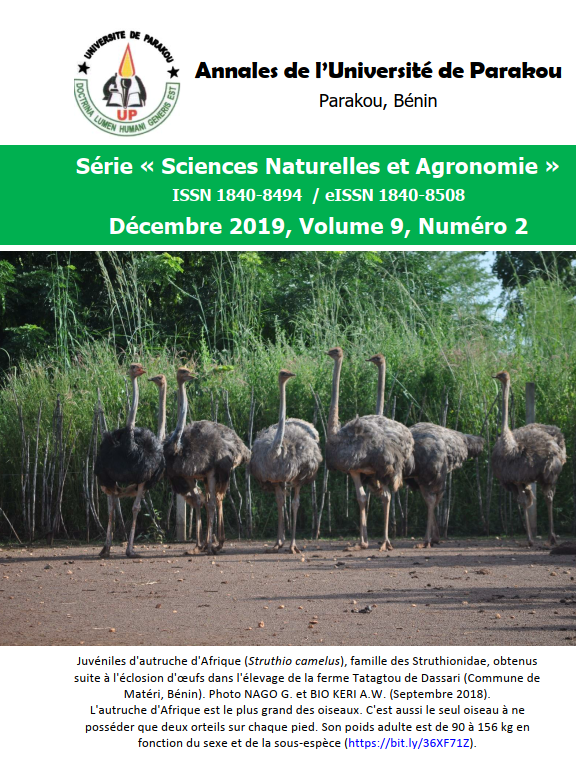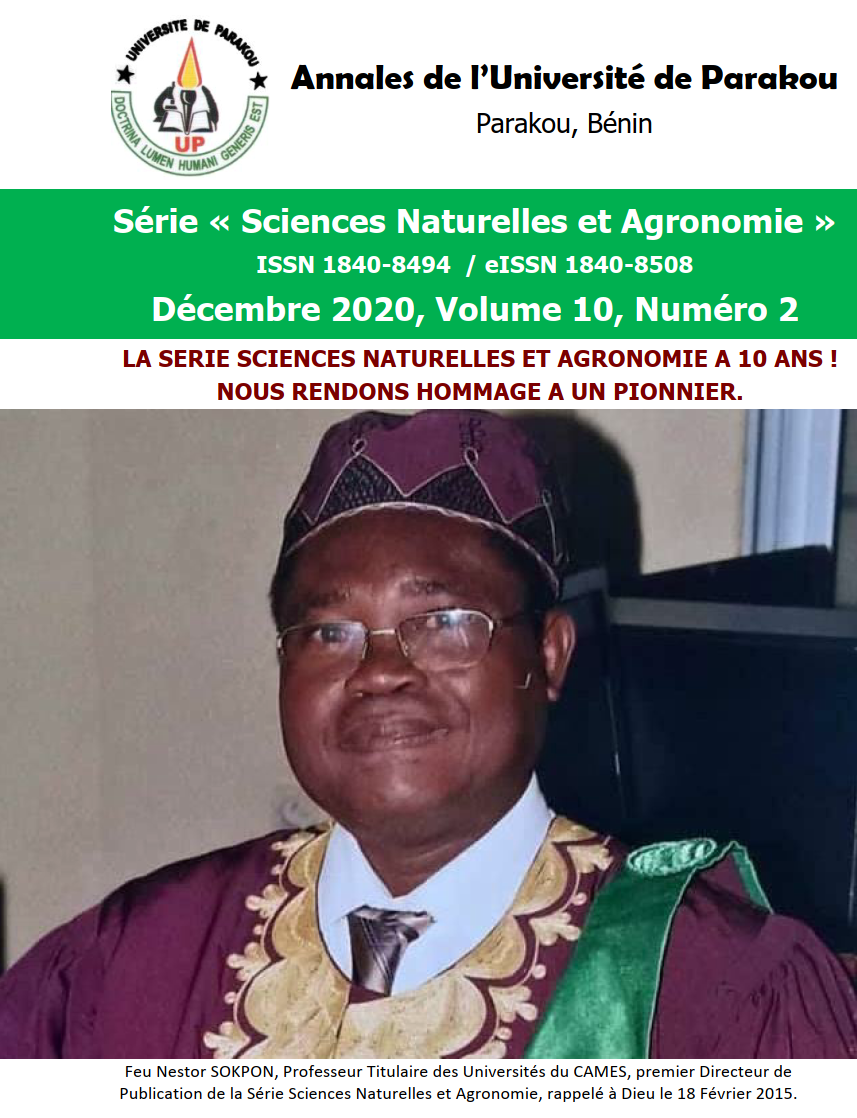Local perception and factors affecting conservation status of gallery forests, habitat of orchid species
DOI :
https://doi.org/10.56109/aup-sna.v9i2.52Mots-clés :
Orchids, gallery forest, Local perception, orchid conservation, habitat degradation, Sudanian woodland, BeninRésumé
In a context of fragmentation of forest landscape and sustainable use of orchid species, an analysis of the local knowledge base is necessary for developing conservation strategies of orchid habitat. This study aims at i) assessing factors affecting local perception of conservation status of orchid habitats, and ii) determining degradation factors of their habitat in Sudanian woodlands and the consequences of the degradation. We used a questionnaire-based survey, to cross knowledges on orchids and habitat degradation, from the four main socio-cultural groups, including the age, the sex and the level of education, translating into 390 respondents. We used the binomial and multinomial logistic regression to assess the local perception on conservation status of orchid habitats with reference to different ethno-demographic groups. We also used the negative binomial generalized linear model (GLM) to test for an existing dependence relation between the local perceptions of the “consequences” of the degradation of gallery forest (as response variable), and the ethno-demographic variables. Ethnicity and level of education significantly influence knowledge on orchids, as well as the perception on their habitat conservation status (p<0.05). The socio-cultural groups Fulani, Gourmantché and Waaba perceived more the degradation of their gallery forests, habitat of orchid species. The three main factors of degradation from local view are tree cutting (65.64%), shifting agriculture (44.10%) and wildfires (39.49%). Whatever the considered GLMs, there is not a significant influence of the ethnodemographic variables on local perception of the consequences of the gallery forests degradation (p< 5%). However, education and ethnicity significantly influence perception on the conservation status of orchid habitat. Assessing how this local perception translates into quantitative data in the field is crucial to develop adaptive strategies for the long term conservation of orchid species and sustainable use of their habitats.
Téléchargements
Métriques
Références
Adjonou K., Djiwa O., Kombate Y., Kokutse A. D. and Kokou K. 2010. Etude de la dynamique spatiale et structure des forêts denses sèches reliques du Togo: implications pour une gestion durable des aires protégées, International Journal of Biological and Chemical Sciences, 4 (1). DOI: https://doi.org/10.4314/ijbcs.v4i1.54242
Assédé E. S. P., Djagoun C. A. M. S., Azihou A. F., Kouton M. D., Gogan Y. S. C., Geldenhuys C. J., Chirwa P. W. and Sinsin B. A. 2017. Folk perceptions and patterns of use of orchid species in Benin, West Africa, Flora et Vegetation Sudano-Sambesica, 20, pp. 26–36. DOI: https://doi.org/10.21248/fvss.20.48
Assédé E. S. P., Djagoun C. A. M. S., Azihou F. A., Gogan Y. S. C., Kouton M. D., Adomou A. C., Geldenhuys C. J., Chirwa P. W. and Sinsin B. 2018. Efficiency of conservation areas to protect orchid species in Benin, West Africa, South African Journal of Botany, 116, pp. 230–237. DOI: https://doi.org/10.1016/j.sajb.2018.02.405
Barbault R. 2008. Écologie générale-6e éd.: Structure et fonctionnement de la biosphère. Dunod.
Boffa J.-M. 2015. Opportunities and challenges in the improvement of the shea (Vitellaria paradoxa) resource and its management, Occasional Paper, 24.
Bouko B. S., Sinsin B. and Soulé B. G. 2007. Effets de la dynamique d’occupation du sol sur la structure et la diversité floristique des forêts claires et savanes au Bénin, Tropicultura, 25 (4), pp. 221–227.
Campos M. T. and Ehringhaus C. 2003. Plant virtues are in the eyes of the beholders: a comparison of known palm uses among indigenous and folk communities of southwestern Amazonia, Economic Botany, 57 (3), pp. 324. DOI: https://doi.org/10.1663/0013-0001(2003)057[0324:PVAITE]2.0.CO;2
CENAGREF 2016. Plan d’Aménagement et de Gestion Participative de la Réserve de Biosphère de la Pendjari. Programme d’appui aux Parcs de l’Entente, Composante 2 PAPE Composante 2. Cotonou, Bénin, p. 124.
Chaturvedi R. K., Raghubanshi A. S. and Singh J. S. 2017a. Sapling harvest: A predominant factor affecting future composition of tropical dry forests, Forest Ecology and Management, 384, pp. 221–235. DOI: https://doi.org/10.1016/j.foreco.2016.10.026
Chaturvedi R. K., Raghubanshi A. S., Tomlinson K. W. and Singh J. S. 2017b. Impacts of human disturbance in tropical dry forests increase with soil moisture stress, Journal of Vegetation Science, 28 (5), pp. 997–1007. DOI: https://doi.org/10.1111/jvs.12547
Costanza R., De Groot R., Sutton P., Van der Ploeg S., Anderson S. J., Kubiszewski I., Farber S. and Turner R. K. 2014. Changes in the global value of ecosystem services, Global Environmental Change, 26, pp. 152–158. DOI: https://doi.org/10.1016/j.gloenvcha.2014.04.002
Dagnelie P. 1998. Statistique théorique et appliquée. Tome 2. Inférence statistique à une et à deux dimensions, De Boeck Université, Paris.
De Caluwé E., De Smedt S., Assogbadjo A. E., Samson R., Sinsin B. and Van Damme P. 2009. Ethnic differences in use value and use patterns of baobab (Adansonia digitata L.) in northern Benin, African Journal of Ecology, 47 (3), pp. 433–440. DOI: https://doi.org/10.1111/j.1365-2028.2008.01023.x
Djogbenou C. P., Glèlè Kakaï R., Arouna O. and Sinsin B. 2011. Analyse des perceptions locales des aménagements forestiers participatifs au Bénin, [VertigO] La Revue Électronique En Sciences de l’environnement, 11 (1). DOI: https://doi.org/10.4000/vertigo.10893
Fandohan A. B., Assogbadjo A. E., Kakaï R. L. G., Sinsin B. and Van Damme P. 2010a. Impact of habitat type on the conservation status of tamarind (Tamarindus indica L.) populations in the W National Park of Benin, Fruits, 65 (1), pp. 11–19. DOI: https://doi.org/10.1051/fruits/2009037
Fandohan B., Assogbadjo A. E., Kakaï R. G., Kyndt T., De Caluwé E., Codjia J. T. C. and Sinsin B. 2010b. Women’s traditional knowledge, use value, and the contribution of tamarind (Tamarindus indica L.) to rural households’ cash income in Benin, Economic Botany, 64 (3), pp. 248–259. DOI: https://doi.org/10.1007/s12231-010-9123-2
Gouwakinnou G. N., Lykke A. M., Assogbadjo A. E. and Sinsin B. 2011a. Local knowledge, pattern and diversity of use of Sclerocarya birrea, Journal of Ethnobiology and Ethnomedicine, 7 (1), pp. 8. DOI: https://doi.org/10.1186/1746-4269-7-8
Gouwakinnou G. N., Lykke A. M., Djossa B. A. and Sinsin B. 2011b. Folk perception of sexual dimorphism, sex ratio, and spatial repartition: implications for population dynamics of Sclerocarya birrea [(A. Rich) Hochst] populations in Benin, West Africa, Agroforestry Systems, 82 (1), pp. 25–35. DOI: https://doi.org/10.1007/s10457-011-9371-x
Haddad M., Brudvig A., Clobert J., Davies F. and Gonzalez A. 2015. Habitat fragmentation and its lasting impact on Earth’s ecosystems, Science Advances, 1 (2). DOI: https://doi.org/10.1126/sciadv.1500052
Houessou L. G., Teka O., Imorou I. T., Lykke A. M. and Sinsin B. 2013. Land use and land-cover change at" W" Biosphere Reserve and its surroundings areas in Benin Republic (West Africa), Environment and Natural Resources Research, 3 (2), pp. 87. DOI: https://doi.org/10.5539/enrr.v3n2p87
INSAE 2013. Effectifs de la population des villages et quartiers de villes du Bénin (RGPH-4), Institut National de la Statistique et de l’Analyse Économique (INSAE), Cotonou, Bénin.
Maazou R., Rabiou H., Issiaka Y., Abdou L., Saidou S. I. and Mahamane A. 2017. Influence de l’occupation des terres sur la dynamique des communautés végétales en zone Sahélienne: cas de la commune rurale de Dantchandou (Niger), International Journal of Biological and Chemical Sciences, 11 (1), pp. 79–92. DOI: https://doi.org/10.4314/ijbcs.v11i1.7
Miles L., Newton A. C., DeFries R. S., Ravilious C., May I., Blyth S., Kapos V. and Gordon J. E. 2006. A global overview of the conservation status of tropical dry forests, Journal of Biogeography, 33 (3), pp. 491–505. DOI: https://doi.org/10.1111/j.1365-2699.2005.01424.x
Millennium Ecosystem Assessment, 2005. Ecosystems and Human Well-being: Biodiversity Synthesis. World Resources Institute, Washington, DC.
Mouhamadou I. T., Imorou I. T., Mèdaho A. S. and Sinsin B. 2013. Perceptions locales des déterminants de la fragmentation des îlots de forêts denses dans la région des Monts Kouffé au Bénin, Journal of Applied Biosciences, 66, pp. 5049–5059. DOI: https://doi.org/10.4314/jab.v66i0.95002
Niggemann M., Jetzkowitz J., Brunzel S., Wichmann M. C. and Bialozyt R. 2009. Distribution patterns of plants explained by human movement behaviour, Ecological Modelling, 220 (9–10), pp. 1339–1346. DOI: https://doi.org/10.1016/j.ecolmodel.2009.02.018
N’zebo J.-M., Dje K. M. and Ahi A. P. 2018. État des connaissances et usages traditionnels des fruits de Tetrapleura tetraptera ((Schumach. & Thonn.) Taub., 1891), plante spontanée aromatique alimentaire du sud-est de la Côte d’Ivoire, Journal of Animal & Plant Sciences, 38 (1), pp. 6190–6205.
Ousséni A., Ismaïla T., Paul D. C. and Brice S. 2011. Comparative analysis of local populations’ perceptions of socio-economic determinants of vegetation degradation in sudano-guinean area in Benin (West Africa), International Journal of Biodiversity and Conservation, 3 (7), pp. 327–337.
Pilli R. and Pase A. 2018. Forest functions and space: a geohistorical perspective of European forests, IForest-Biogeosciences and Forestry, 11 (1), pp. 79. DOI: https://doi.org/10.3832/ifor2316-010
Raffaelli D. G. and Frid C. L. 2010. Ecosystem ecology: a new synthesis. Cambridge University Press. DOI: https://doi.org/10.1017/CBO9780511750458
Shackleton S., Campbell B., Wollenberg E. and Edmunds D. 2002. Devolution and community-based natural resource management: Creating space for local people to participate and benefit, Natural Resource Perspectives, 76 (1), pp. 1–6. DOI: https://doi.org/10.4314/zsn.v36i1.18553
Sieber S. S., Medeiros P. M. and Albuquerque U. P. 2011. Local perception of environmental change in a semi-arid area of Northeast Brazil: a new approach for the use of participatory methods at the level of family units, Journal of Agricultural and Environmental Ethics, 24 (5), pp. 511–531. DOI: https://doi.org/10.1007/s10806-010-9277-z
Singh J. S. and Chaturvedi R. K. 2017. Tropical dry deciduous forest: Research trends and emerging features. Springer. DOI: https://doi.org/10.1007/978-981-10-7260-4
Sinsin B. and Kampmann D. 2010. Atlas de la Biodiversité de l’Afrique de l’Ouest, Tome I: Bénin/Biodiversity Atlas of West Africa, Volume I: Bénin. Cotonou & Frankfurt/Main: BIOTA.
Tchibozo E. A. 2014. Landscape characterization and modeling degradation by fragmentation of plant formations: Case of Ketu and Dogo classified forest (East Center of Benin), Landscape, 3 (12).
Vodouhê F. G., Coulibaly O., Greene C. and Sinsin B. 2009. Estimating the local value of non-timber forest products to pendjari biosphere reserve dwellers in Benin, Economic Botany, 63 (4), pp. 397. DOI: https://doi.org/10.1007/s12231-009-9102-7
Yaro J. A. 2013. The perception of and adaptation to climate variability/change in Ghana by small-scale and commercial farmers, Regional Environmental Change, 13 (6), pp. 1259–1272. DOI: https://doi.org/10.1007/s10113-013-0443-5
Yeo K., Tiho S., Ouattara K., Konate S., Kouakou L. M. M. and Fofana M. 2013. Impact de la fragmentation et de la pression humaine sur la relique forestière de l’Université d’Abobo-Adjamé (Côte d’Ivoire)., Journal of Applied Biosciences, 61, pp. 4551–4565. DOI: https://doi.org/10.4314/jab.v61i0.85602
Zizka A., Thiombiano A., Dressler S., Nacoulma B. M., Ouédraogo A., Ouédraogo I., et al. 2015. The vascular plant diversity of Burkina Faso (West Africa)—A quantitative analysis and implications for conservation, Candollea, 70 (1), pp. 9–20. DOI: https://doi.org/10.15553/c2015v701a2














